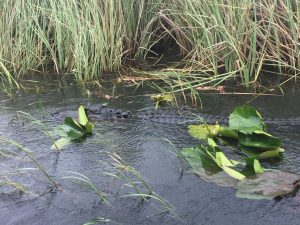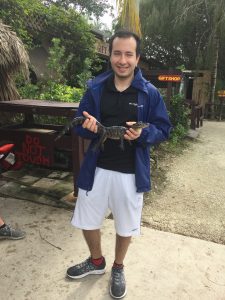Posted November 10, 2016
By JACOB RUBIN
COOPERTOWN, Fla. — The first thing I thought of when I arrived at Coopertown Airboat Rides in the Everglades was how this place didn’t look anything like where I had just been 20 or 30 minutes earlier.

Al Capone in his natural habitat (Photos by Jacob Rubin).
Coming from South Miami, the Everglades might as well have been on a different planet, a planet replete with gangly trees and wood planks and easy-going outdoorsy people with hats and sunglasses that wrap around their heads.
I couldn’t have been more excited to go on my first airboat ride; I had high expectations and I’m pleased to say that they were surely met and then some.
After purchasing my ticket, a lady that works at Coopertown offered to take my picture in front of a green screen. I accepted and she told me to point to the ground on my right hand side and seem frightened as if I was pointing at an alligator. She then told me I’d be able to see the picture when I got back from the tour. Originally, I was supposed to go on boat #3, but boat #2 had an opening for one more person so I was offered to take a seat on the boat.
I sat in the second row behind a family of four from Norway. The father, Erik, told me that this was their first time in America and he had seen a documentary about the Everglades a few years back and really wanted to come and check it out.
“I saw there were a bunch of animals and different trees and plants here and I knew it was such a different kind of place than Norway, I had to see it for myself,” said Erik.
After waiting in the boat for a few minutes, our tour guide came over and untied the boat from the dock. The tour guide, Dave, was very humorous and rattled off a bunch of one-liners in quick succession as he situated himself onto the boat and introduced himself.
“This is my first day on the job, guys,” Dave cracked.
The airboat consisted of five rows of seats with Dave sitting elevated several feet in the air on a chair in the very back of the boat. Dave graciously offered everyone on board two cotton balls each to serve as ear protection. As we slowly started making our way down the open sawgrass I tried to observe as much as I possibly could, trying to take in the ripples in the water, the plants, the sky and the words of Dave.
As Dave started to speed up the boat as we got into more of an open area, he stopped talking as the engine of the boat began roaring louder and louder making me feel grateful for my ear protection, which was surprisingly effective given the nature of the material.

The author posing with Louie the Alligator.
Whenever Dave needed to make a turn, he would turn the boat sideways and drift the boat. It was very reminiscent of cars drifting around corners on a racetrack; it was kind of scary because it seemed as if the side of the boat would hit the hammocks (small islands of plants), but we’d always end up narrowly missing them by a few inches. I expected the ride to be a bit choppy and bumpy given the nature of the airboat, but the entire ride was very smooth.
A man sitting in the row behind me almost lost his hat due to strong gusts of wind and my sunglasses almost flew off my head once or twice.
After driving for a few minutes or so we stopped by what Dave described as a “hardwood hammock.” The hammock was essentially a very small island of maybe 10 square feet or so filled with different plants.
Dave told us that the Native Americans that used to live in this area would use these hammocks as landmarks when navigating the area and were able to distinguish between hundreds of these hammocks even though they virtually all look identical. I thought in that moment that if I somehow got lost by myself out here in this saw grass that I would most likely be a goner, because outside of these hammocks there are basically no defining landmarks to use to get back to land.
“The Everglades is about 75 percent water and 25 percent land,” Dave told us with great enthusiasm. “The tall, pointy grass that you see all around you is called sawgrass. Over way back there to the left of us is needle grass. The water here can be as shallow as a few inches or as deep as a few feet depending on the time.”
Everyone on board at this point took out their cameras and took pictures. I highly recommend taking a panoramic photograph at this point in the tour because you can get a clear 360-degree view of the environment that makes for a very scenic and beautiful photograph.
On the particular day, the weather was slightly overcast and it had lightly rained on and off during the duration of the tour. While this might not seem very pleasant, it was a nice alternative to the hot, humid afternoons that are usually the norm in the fall in this part of the Everglades. I would not discourage you from going on an overcast day and keep in mind that, even though it may not seem that sunny, it’s still a good idea to use sunscreen because you can still get a sun burn. Additionally, it is important to use bug spray because it can get quite buggy, especially when the boat is idle.
After hearing Dave lecture us for a while about the history of this region and a profile of the ecological landscape, Dave began driving the boat again. I personally enjoyed the moments when the boat would speed across the water more than when we were idle; it was a very calming and serene experience. Dave would alternate drifting the boat to the right and left sides giving everyone on the boat an equal chance at seeing the sawgrass marshes and hardwood hammocks up close.
After driving for a while across a slightly narrow strip of water, Dave stopped the boat and told us that there should be an alligator right around this area. Sure enough, within seconds, an alligator popped its head out of the water about 10 feet or so from the right side of the boat. Excitedly, Dave told us that this alligator’s name was Damien.
Someone on the boat asked Dave how he knew that was Damien and Dave said that Damien is the only alligator that lives in this particular area. I asked Dave why no other alligators live in this area besides Damien and he told me that Damien is very territorial and will attack any alligator that tries to enter the area. He did tell me, however, that Damien would be susceptible to giving up the area to a female alligator if she tried to usurp control of the area.
He joked that it wasn’t because Damien would be acting chivalrous, but rather that female alligators are the more dominant sex despite them being smaller. Dave then described alligators in general, saying that the females have smaller heads and their eyes protrude out of their eye sockets more and told us that the sex of an alligator isn’t determined until the alligator is three years old.
We began searching for more alligators. About five minutes later we encountered two alligators about 20 yards in front of us. Dave told us one of them was named Al Capone and the other was named Grace. Al Capone swam over within a few feet of the boat and everyone on board shot videos and pictures. Al slowly glided through the spatterdocks and water lilies, barely creating ripples in his wake as everyone on board began murmuring excitedly to each other.
We reached the dock about an hour or so after leaving. Dave told us that we could all take turns taking a picture with a baby alligator that they had in captivity named Louie. I got my girlfriend to take a picture of me holding Louie; he felt very slimy and delicate, not unlike a snake. I asked Dave after everyone was done taking pictures with Louie what his favorite part was of working at Coopertown.
“I guess if I had to choose a favorite part of this job it would be seeing the looks on people’s faces when they see the alligators up close, especially the look on children’s faces. It reminds me why I got into this business in the first place, to share what I love so much with people and have them enjoy experiencing what I’m blessed to be a part of every day.”
If You Go
- The ticket prices are $23 for adults, $11 for children ages 7-11, and for children under 7 years old there is no charge.
- Coopertown Airboat Rides is located at 22700 SW 8th St., Miami, Fla., 33194.
- Driving directions from the University of Miami: Go north on U.S. 1 and then turn right onto Sunset Drive. Turn right to merge onto Fla. State Road 826 north toward Miami International Airport. Take exit onto U.S. 41, SW 8th Street. Turn left onto SW 8th Street and in 15 miles the destination will be on your left.
- Driving directions from Miami International Airport: Turn right onto NW 37th Avenue and then turn right onto NW 14th. Turn right onto NW 42nd Avenue and then keep right to merge onto Fla. State Road 836 west. For 6.3 miles keep right onto Florida’s Turnpike. Take exit onto U.S. 41 west, also known as SW 8th Street. In 12 miles, the destination will be on your left.
- Coopertown Airboat Rides is open from 9 a.m. to 5:50 p.m. daily.
- Parking is free at Coopertown Airboat Rides.
- Telephone 305-226-6048.
